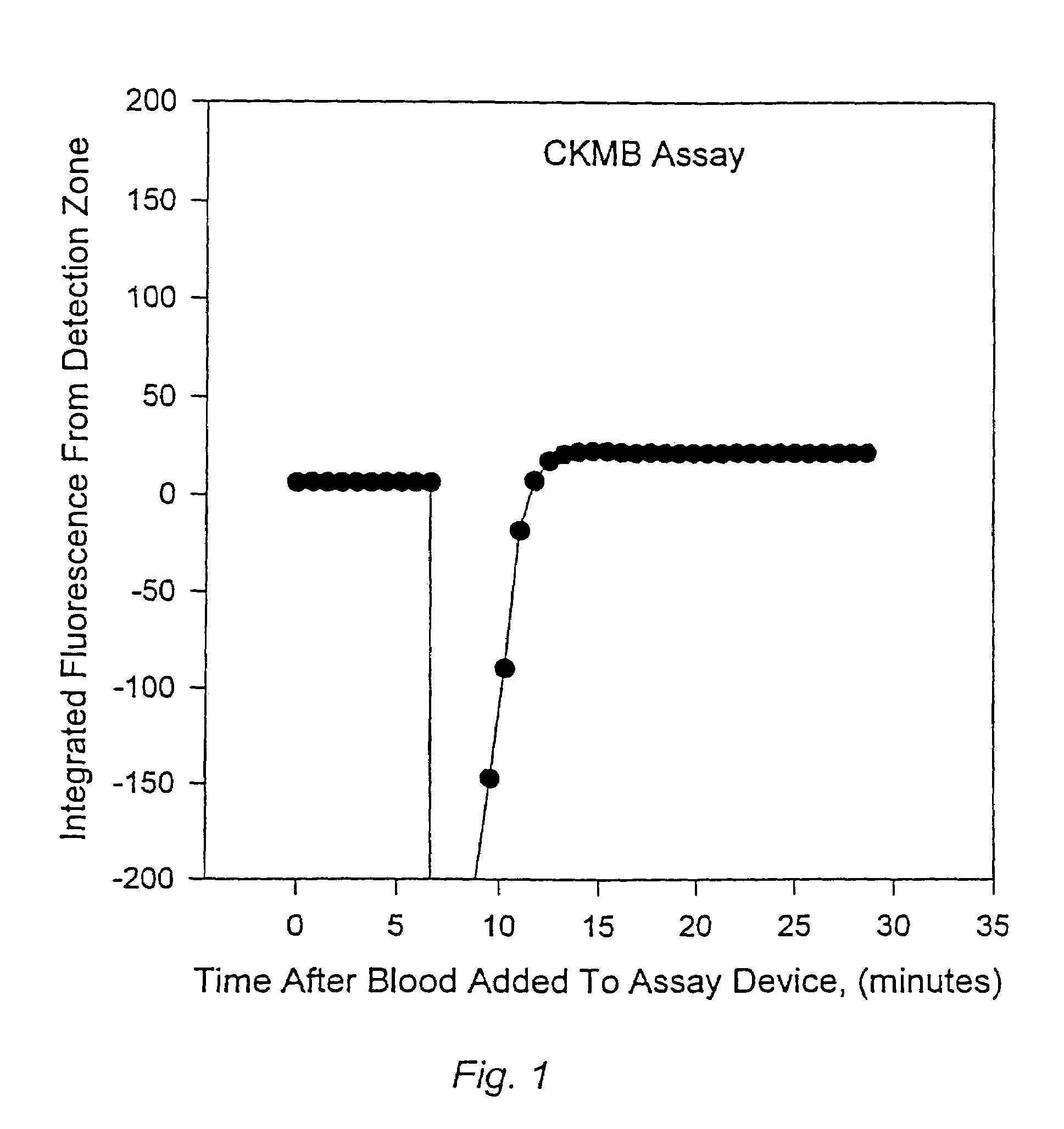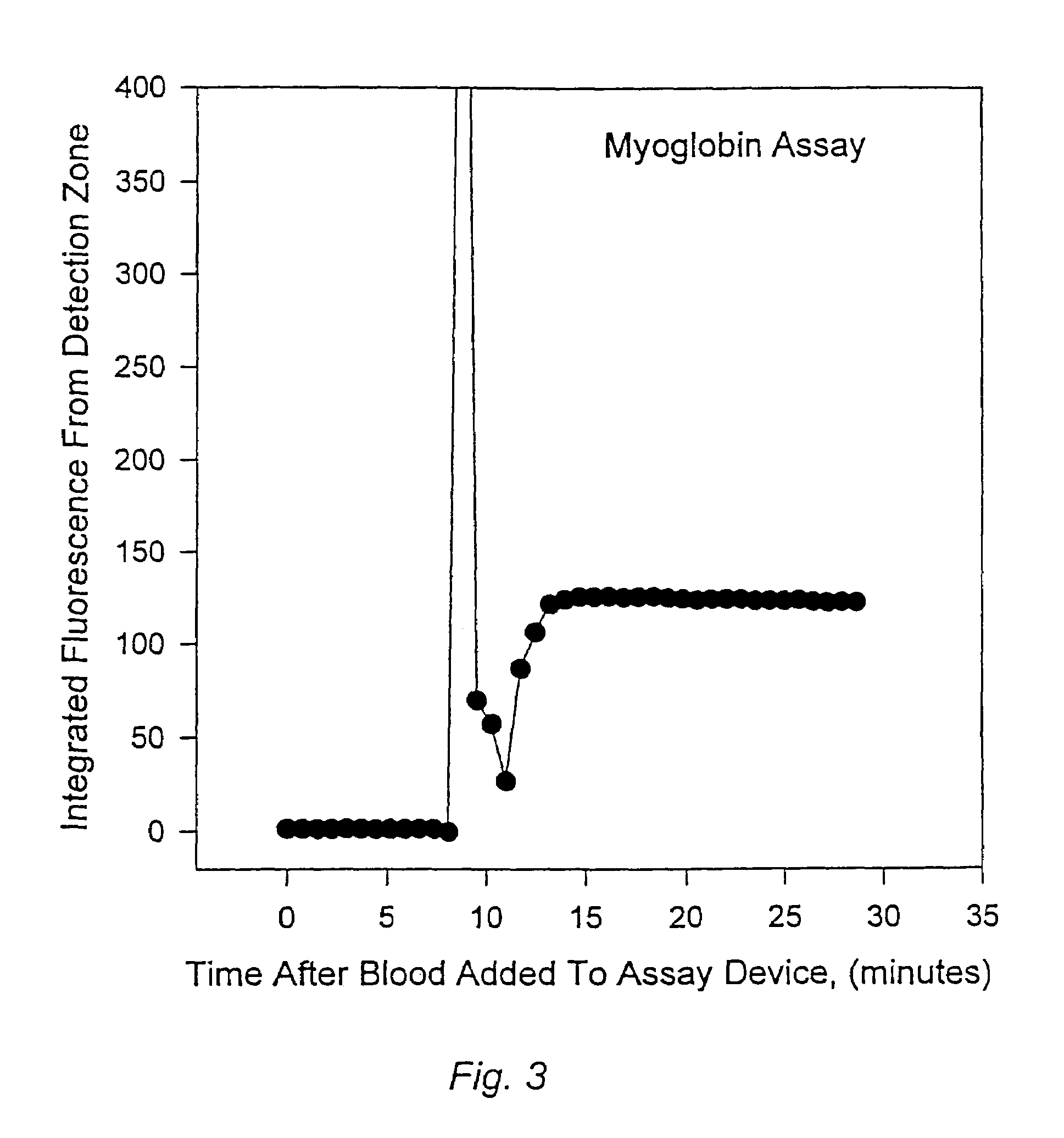Methods for monitoring the status of assays and immunoassays
a technology for immunoassays and assays, applied in the field of methods for monitoring the status of assays and immunoassays, can solve the problems of inability to send blood samples to the hospital laboratory, incompatibility of protocols, personnel and equipment available in the hospital emergency department, and inability to meet the needs of assay results in a rapid tim
- Summary
- Abstract
- Description
- Claims
- Application Information
AI Technical Summary
Benefits of technology
Problems solved by technology
Method used
Image
Examples
example 1
Preparation of Fluorescent Energy Transfer Latex With Bovine Serum Albumin (FETL-BSA) and Antibody (FETL-AB) Conjugates
[0188]Fluorescent energy transfer latex was prepared as described in U.S. patent application Ser. No. 08 / 409,298, filed 23 Mar. 1995 using silicon phthalocyanine bis (di-methylhexylvinylsilyloxide) and silicon [di(1,6-diphenylnaphthalocyanine)]diphthalocyanine bis (di-methylhexylvinylsilyloxide) as donor and acceptor dyes, respectively, at a ratio of 4 moles of donor to 1 mole of acceptor. The latex particles are about 230 nm in diameter and were purchased from Interfacial Dynamics Corporation. The FETL particles were adsorbed with bovine serum albumin (BSA) or various antibodies using techniques that are standard to one skilled in the art. Alternatively, the BSA or the antibodies were attached covalently to the particles using heterobifunctional crosslinking reagents (SMCC and SPDP, from Pierce Chemical Co.) also using techniques that are standard to one skilled in...
example 2
Preparation of Flow Control FETL Conjugate for the Cardiac Marker Assay
[0190]To a solution of FETL-BSA, (11 ml at 1% solids, w / v, 220 nm particles), prepared according to example 1, was added with stirring, ascorbic acid and ethylenediamine tetraacetic acid to final concentrations of 20 mM and 0.1 mM, respectively. SMCC (3.8 μl of a 60 mM solution in acetonitrile) was added with stirring and the solution was incubated at room temperature for 2 h. The reaction was quenched by addition of 0.45 ml of 0.5 M solution of taurine. The solution was applied to a gel filtration column and 23.1 ml FETL-BSA-maleimide was eluted. A solution of decapeptide thiol (19 μl of 4.7 mM solution) was added and the solution was incubated at room temperature for 50 min. Decapeptide thiol was prepared by hydrolysis in as described in Example 4. The solution was applied to a gel filtration column and the eluted FETL-BSA-decapeptide was centrifuged at top speed in an Eppendorf centrifuge for 20 min. The pelle...
example 3
Preparation of Time Gate Control FETL Conjugate for the Cardiac Marker Assay
[0191]To a solution of FETL-BSA, (20 ml at 1% solids, w / v, 220 nm particles), prepared according to example 1, was added with stirring, ascorbic acid and ethylenediamine tetraacetic acid to final concentrations of 20 mM and 0.1 mM, respectively. SMCC (17 μl of a 60 mM solution in acetonitrile) was added to the solution, with stirring, and incubated at room temperature for 2 h. The reaction was quenched by addition of 0.82 ml of 0.5 M solution of taurine. The solution was applied to a gel filtration column and 16.9 ml of FETL-BSA-maleimide was eluted. Morphine-HCTL was synthesized and hydrolyzed to the corresponding thiol derivative as described in U.S. Pat. No. 5,089,391, Example 4, incorporated by reference. Morphine thiol (0.52 ml of a 16.3 mM solution) was added and the solution was incubated at room temperature for 3 h. The reaction was quenched by addition of N-ethyl maleimide to a final concentration o...
PUM
| Property | Measurement | Unit |
|---|---|---|
| sizes | aaaaa | aaaaa |
| sizes | aaaaa | aaaaa |
| sizes | aaaaa | aaaaa |
Abstract
Description
Claims
Application Information
 Login to View More
Login to View More - R&D
- Intellectual Property
- Life Sciences
- Materials
- Tech Scout
- Unparalleled Data Quality
- Higher Quality Content
- 60% Fewer Hallucinations
Browse by: Latest US Patents, China's latest patents, Technical Efficacy Thesaurus, Application Domain, Technology Topic, Popular Technical Reports.
© 2025 PatSnap. All rights reserved.Legal|Privacy policy|Modern Slavery Act Transparency Statement|Sitemap|About US| Contact US: help@patsnap.com



